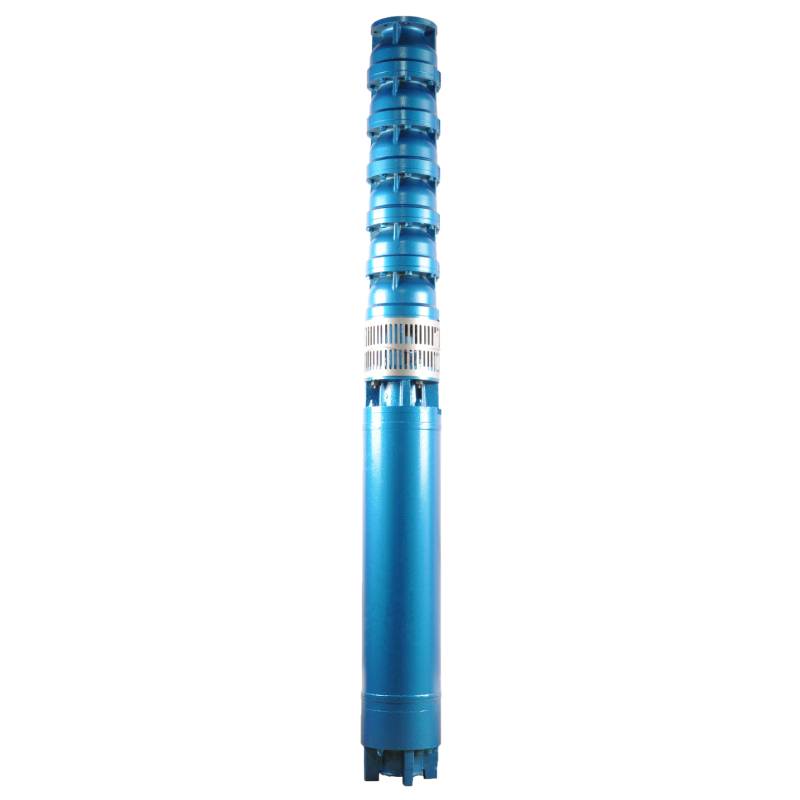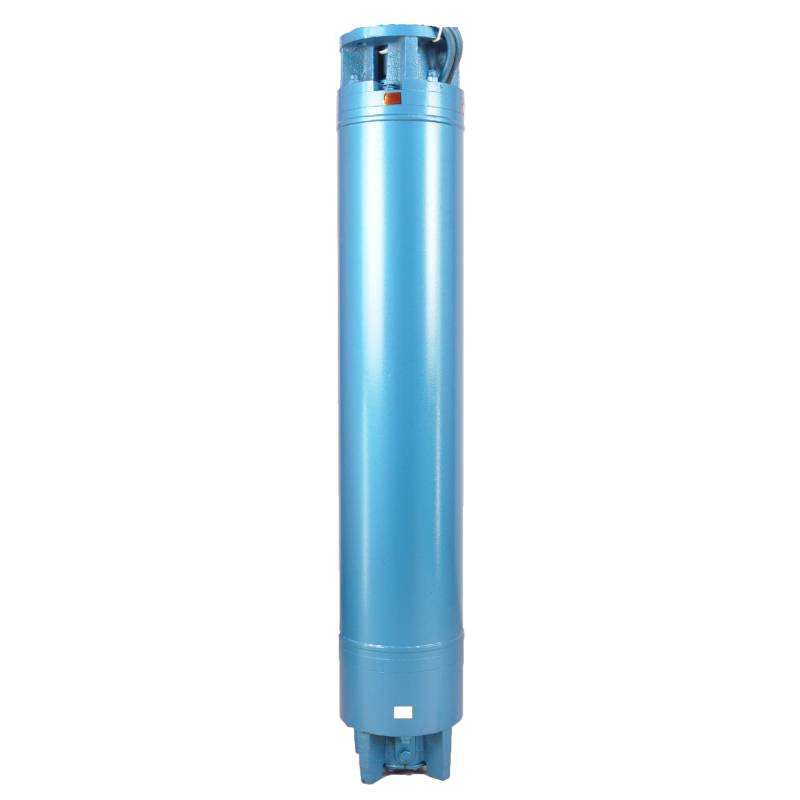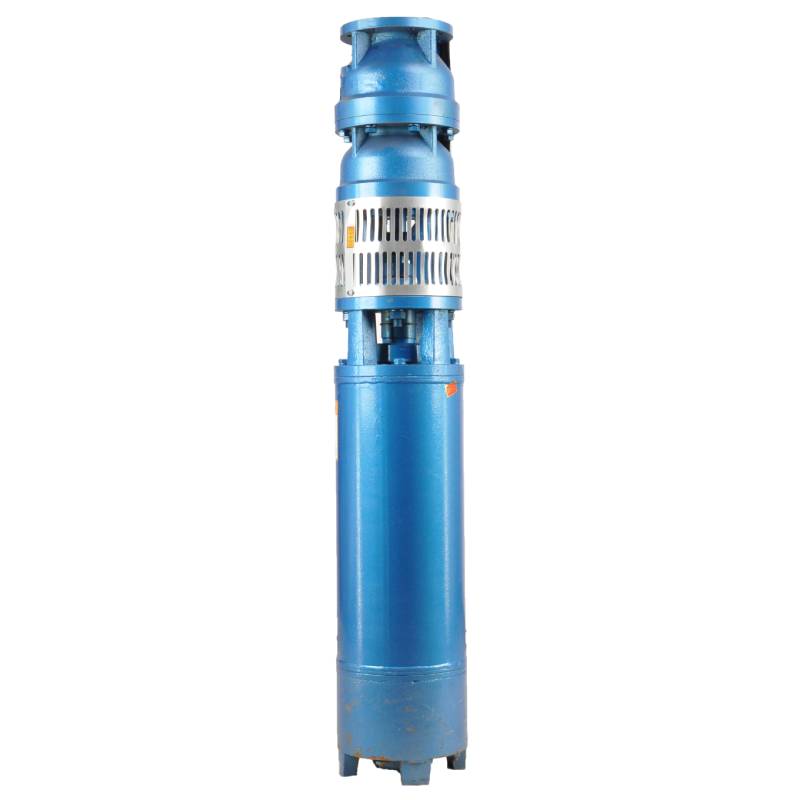The product adopts special waterproof wire design, which can realize long-term stable conversion operation of the motor within the frequency range of 1HZ-50HZ. The frequency conversion winding design not only makes the frequency conversion deep well pump more energy saving, but also prolongs its service life. The motor winding adopts special water-resistant conductors that are resistant to high frequency impact, pulse peak voltage impact and high temperature aging, with excellent characteristics and stability.
The product is powered by three-phase AC 380V power supply, 50HZ frequency, suitable for the environment with harsh water quality conditions. Specific requirements include water temperature below 20 °C, solid impurities content is not greater than 0.01%, PH value is 6.5-8.5, hydrogen sulfide content is not greater than 1.5mg/L, chloride ion content is not greater than 400mg/L. The product adopts closed or water immersion structure of the motor, before use to ensure that the pump is fully filled with water, no-load test run is strictly prohibited. The pump must be completely immersed in water, not more than 70m water depth, water source to meet the requirements of the pump water output and continuous operation. In addition, the well must be vertical, the pump can only be used vertically. The wiring should be supported according to the requirements, and equipped with external overload protection device. This series of requirements to ensure the efficient and stable operation of the product, suitable for all kinds of special environment of the pump demand.
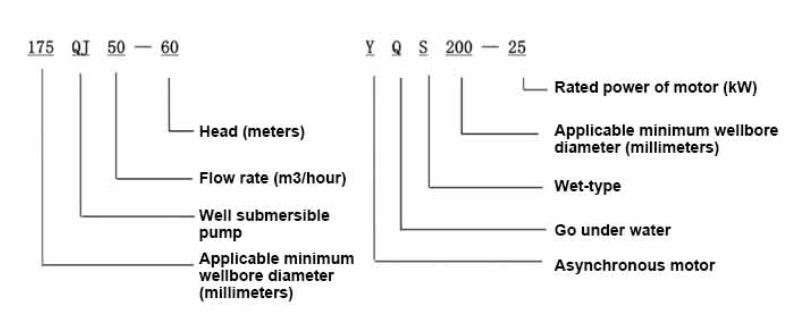
| Hoʻohālike | Kahe (m3/h) | Poʻo (m) |
Holoi wikiwiki (hoʻololi / kiko) |
Pum wai(%) | puka puka anawaena (mm) |
Kūpono maikaʻi anawaena(mm) |
Heluhelu ʻia power(KW) |
Heluhelu ʻia uila (V) |
Heluhelu ʻia kēia manawa(A) |
Kaʻa kaʻa (%) | power factorcosφ | Unite Ka nui o ka Radial (mm) |
ʻŌlelo | |||||||||
| 250QJ50-40 | 50 | 40 | 2875 | 72 | 80 | 250maluna | 9.2 | 380 | 21.7 | 78.5 | 0.82 | 233 | ||||||||||
| 250QJ50-60 | 60 | 13 | 30.1 | 80.0 | 0.82 | |||||||||||||||||
| 250QJ50-80 | 80 | 18.5 | 40.8 | 82.0 | 0.84 | |||||||||||||||||
| 250QJ50-100 | 100 | 22 | 47.9 | 83.0 | 0.84 | |||||||||||||||||
| 250QJ50-120 | 120 | 25 | 53.8 | 84.0 | 0.84 | |||||||||||||||||
| 250QJ50-140 | 140 | 30 | 64.2 | 84.5 | 0.84 | |||||||||||||||||
| 250QJ50-160 | 160 | 37 | 77.8 | 85.0 | 0.85 | |||||||||||||||||
| 250QJ50-200 | 200 | 45 | 94.1 | 85.5 | 0.85 | |||||||||||||||||
| 250QJ50-240 | 240 | 55 | 114.3 | 86.0 | 0.85 | |||||||||||||||||
| 250QJ50-280 | 280 | 63 | 131.0 | 86.0 | 0.85 | |||||||||||||||||
| 250QJ50-320 | 320 | 75 | 152.3 | 87.0 | 0.86 | |||||||||||||||||
| 250QJ50-400 | 400 | 90 | 182.8 | 87.0 | 0.86 | |||||||||||||||||
| 250QJ50-440 | 440 | 100 | 203.1 | 87.0 | 0.86 | |||||||||||||||||
| 250QJ63-40 | 63 | 40 | 2875 | 74 | 80 | 250maluna | 11 | 380 | 25.8 | 79.0 | 0.82 | 233 | ||||||||||
| 250QJ63-60 | 60 | 18.5 | 40.8 | 82.0 | 0.84 | |||||||||||||||||
| 250QJ63-80 | 80 | 22 | 47.9 | 83.0 | 0.84 | |||||||||||||||||
| 250QJ63-100 | 100 | 30 | 64.2 | 84.5 | 0.84 | |||||||||||||||||
| 250QJ63-120 | 120 | 37 | 77.8 | 85.0 | 0.85 | |||||||||||||||||
| 250QJ63-160 | 160 | 45 | 94.1 | 85.5 | 0.85 | |||||||||||||||||
| 250QJ63-200 | 200 | 55 | 114.3 | 86.0 | 0.85 | |||||||||||||||||
| 250QJ63-220 | 220 | 63 | 131.0 | 86.0 | 0.85 | |||||||||||||||||
| 250QJ63-260 | 260 | 75 | 152.3 | 87.0 | 0.86 | |||||||||||||||||
| 250QJ63-300 | 300 | 90 | 182.8 | 87.0 | 0.86 | |||||||||||||||||
| 250QJ63-360 | 360 | 100 | 203.1 | 87.0 | 0.86 | |||||||||||||||||
| 250QJ80-20 | 80 | 20 | 2875 | 75 | 100 | 250maluna | 7.5 | 380 | 18.0 | 78.0 | 0.81 | 233 | ||||||||||
| 250QJ80-40 | 40 | 15 | 33.9 | 81.0 | 0.83 | |||||||||||||||||
| 250QJ80-60 | 60 | 22 | 47.9 | 83.0 | 0.84 | |||||||||||||||||
| 250QJ80-80 | 80 | 30 | 64.2 | 84.5 | 0.84 | |||||||||||||||||
| 250QJ80-100 | 100 | 37 | 77.8 | 85.0 | 0.85 | |||||||||||||||||
| 250QJ80-120 | 120 | 45 | 94.1 | 85.5 | 0.85 | |||||||||||||||||
| 250QJ80-160 | 80 | 160 | 2875 | 75 | 100 | 250maluna | 55 | 380 | 114.3 | 86.0 | 0.85 | 233 | ||||||||||
| 250QJ80-180 | 180 | 63 | 131.0 | 86.0 | 0.85 | |||||||||||||||||
| 250QJ80-200 | 200 | 75 | 152.3 | 87.0 | 0.86 | |||||||||||||||||
| 250QJ80-240 | 240 | 90 | 182.8 | 87.0 | 0.86 | |||||||||||||||||
| 250QJ80-280 | 280 | 100 | 203.1 | 87.0 | 0.86 | |||||||||||||||||
| 250QJ100-18 | 100 | 18 | 2875 | 75 | 100 | 250maluna | 7.5 | 380 | 18.0 | 78.0 | 0.81 | 233 | ||||||||||
| 250QJ100-36 | 36 | 15 | 33.9 | 81.0 | 0.83 | |||||||||||||||||
| 250QJ100-54 | 54 | 25 | 53.8 | 84.0 | 0.84 | |||||||||||||||||
| 250QJ100-72 | 72 | 30 | 64.2 | 84.5 | 0.84 | |||||||||||||||||
| 250QJ100-90 | 90 | 37 | 77.8 | 85.0 | 0.85 | |||||||||||||||||
| 250QJ100-108 | 108 | 45 | 94.1 | 85.5 | 0.85 | |||||||||||||||||
| 250QJ100-126 | 126 | 55 | 114.3 | 86.0 | 0.85 | |||||||||||||||||
| 250QJ100-144 | 144 | 63 | 131.0 | 86.0 | 0.85 | |||||||||||||||||
| 250QJ100-162 | 162 | 75 | 152.3 | 87.0 | 0.86 | |||||||||||||||||
| 250QJ100-198 | 198 | 90 | 182.8 | 87.0 | 0.86 | |||||||||||||||||
| 250QJ100-216 | 216 | 100 | 203.1 | 87.0 | 0.86 | |||||||||||||||||
| 250QJ125-16 | 125 | 16 | 2875 | 76 | 125 | 250maluna | 9.2 | 380 | 21.7 | 78.5 | 0.82 | 233 | ||||||||||
| 250QJ125-32 | 32 | 18.5 | 40.8 | 82.0 | 0.84 | |||||||||||||||||
| 250QJ125-48 | 48 | 25 | 53.8 | 84.0 | 0.84 | |||||||||||||||||
| 250QJ125-64 | 64 | 37 | 77.8 | 85.0 | 0.85 | |||||||||||||||||
| 250QJ125-80 | 80 | 45 | 94.1 | 85.5 | 0.85 | |||||||||||||||||
| 250QJ125-96 | 96 | 55 | 114.3 | 86.0 | 0.85 | |||||||||||||||||
| 250QJ125-112 | 112 | 63 | 131.0 | 86.0 | 0.85 | |||||||||||||||||
| 250QJ125-128 | 128 | 75 | 152.3 | 87.0 | 0.86 | |||||||||||||||||
| 250QJ125-160 | 160 | 90 | 182.8 | 87.0 | 0.86 | |||||||||||||||||
| 250QJ125-176 | 176 | 100 | 203.1 | 87.0 | 0.86 | |||||||||||||||||
| 250QJ125-192 | 192 | 110 | 219.6 | 87.5 | 0.87 | |||||||||||||||||
| 250QJ140-15 | 140 | 15 | 2875 | 76 | 125 | 250maluna | 9.2 | 380 | 21.7 | 78.5 | 0.82 | 233 | ||||||||||
| 250QJ140-30 | 30 | 18.5 | 40.8 | 82.0 | 0.84 | |||||||||||||||||
| 250QJ140-45 | 45 | 30 | 64.2 | 84.5 | 0.84 | |||||||||||||||||
| 250QJ140-60 | 60 | 37 | 77.8 | 85.0 | 0.85 | |||||||||||||||||
| 250QJ140-75 | 45 | 45 | 94.1 | 85.5 | 0.85 | |||||||||||||||||
| 250QJ140-90 | 90 | 55 | 114.3 | 86.0 | 0.85 | |||||||||||||||||
| 250QJ140-105 | 140 | 105 | 2875 | 76 | 125 | 250maluna | 63 | 380 | 131.0 | 86.0 | 0.85 | 233 | ||||||||||
| 250QJ140-120 | 120 | 75 | 152.3 | 87.0 | 0.86 | |||||||||||||||||
| 250QJ140-150 | 150 | 90 | 182.8 | 87.0 | 0.86 | |||||||||||||||||
| 250QJ140-165 | 165 | 100 | 203.1 | 87.0 | 0.86 | |||||||||||||||||
| 250QJ140-180 | 180 | 110 | 219.6 | 87.5 | 0.87 | |||||||||||||||||
| 250QJ200-20 | 200 | 20 | 2875 | 75 | 150 | 250maluna | 18.5 | 380 | 40.8 | 82.0 | 0.84 | 233 | ||||||||||
| 250QJ200-40 | 40 | 37 | 77.8 | 85.0 | 0.85 | |||||||||||||||||
| 250QJ200-60 | 60 | 55 | 114.3 | 86.0 | 0.85 | |||||||||||||||||
| 250QJ200-80 | 80 | 75 | 152.3 | 87.0 | 0.86 | |||||||||||||||||
| 250QJ200-100 | 100 | 90 | 182.8 | 87.0 | 0.86 | |||||||||||||||||
| 250QJ200-120 | 120 | 100 | 203.1 | 87.0 | 0.86 | |||||||||||||||||
| 250QJ200-140 | 140 | 125 | 249.5 | 87.5 | 0.87 | |||||||||||||||||
1, well submersible pump for clean water pump, prohibit the new well, pumping sediment and muddy water,
2, well water pump voltage grade of 380/50HZ, the use of other voltage grades of submersible motors need to be customized. The underground cable must use waterproof cable, must be equipped with starting equipment, such as distribution box, start not ready should have commonly used motor comprehensive protection function, such as short circuit overload protection, phase protection, undervoltage protection, grounding protection, idling protection, in case of abnormal conditions, the protection device should be timely action trip.
3, the installation and use of the pump must be reliably grounded, prohibit the push and pull switch when the hands and feet are wet, the installation and maintenance of the pump must be cut off the power supply, the use of the pump place to set up "to prevent electric shock" obvious signs:
4, down the well or before installation, the motor cavity must be filled with distilled water or non-corrosive clean cold boiling water, tighten the / water bolt, the pump on the ground test run, must be to the pump chamber water lubrication rubber bearings, instant start not more than a second, see whether the steering is the same as the steering instructions. When the pump is upright, pay attention to safety, prevent overturning injury.
5, e like me nā ʻōlelo o ka hoʻokiʻekiʻe ʻana o ka pauma, ke kahe o ka hoʻohana ʻana, e pale i ke kahe haʻahaʻa a i ʻole ka hoʻokiʻekiʻe kiʻekiʻe o ka pumping ikaika, ke kuʻi ʻana a me nā ʻāpana ʻē aʻe o ka ʻaʻahu, ua wela ke kaʻa.
6, after the pump down the well, the measurement of the motor to the ground insulation resistance should not be less than 100M, after the start to observe the voltage and current, check the motor winding insulation, whether in line with the requirements; pump storage location temperature if less than freezing point, should be dry the motor cavity water, prevent the motor cavity water ice damage caused by low temperature.
The pump parts are mainly composed of pump shaft, impeller, shunt shell, rubber bearing, check valve body and so on; the motor part mainly includes base, pressure regulating diaphragm, thrust bearing, thrust plate, lower guide bearing seat, stator, rotor, upper guide bearing seat, sand discharging ring, water inlet section, cable lead, etc. The main characteristic of the product is that the motor is a water-filled wet submersible three-phase asynchronous motor, the motor cavity is filled with water, used to cool the motor and lubricate the bearing; the pressure regulating diaphragm at the bottom is used to adjust the expansion and contraction pressure difference of the internal water caused by the change of the temperature rise of the motor. In order to prevent the sand particles in the well water from entering the motor, two sand sealing rings are installed on the upper end of the motor shaft extension, and a sand discharging ring is installed to form a sand prevention structure. To prevent the pump shaft from jumping when starting up, the pump shaft is connected with the motor shaft through a coupling, and the thrust bearing is installed on the lower part of the motor. The motor and pump bearing adopt water lubrication technology, and the stator winding of the motor adopts high quality submersible motor winding with high insulation performance. The pump is designed by computer CAD, with simple structure and excellent technical performance.

(1) Hoʻomākaukau ma mua o ke kau ʻana:
1. E nānā inā kūpono ka pauma submersible i nā kūlana hoʻohana a me ka laulā i ʻōlelo ʻia ma ka manual.
2. Ma ka hoʻohana ʻana i kahi obiect kaumaha me ke anawaena e like me ke anawaena o waho loa o ka pauma hoʻohaʻahaʻa, e ana inā hiki i ka inneldiameter o ka luawai ke hoʻokomo i ka pauma hoʻoheheʻe ʻia, a e ana i ka hoʻokō ʻana o ka hohonu i nā koi hoʻokomo.
3. E nānā i ka maʻemaʻe o ka luawai a me ka wai o ka pūnāwai. Mai hoʻohana i ka pauma uila e holoi ai i ka ʻōpala welor a me ka wai one no ka pale ʻana i ka pōʻino mua o ka pauma uila.
4. E nānā inā kūpono ke kūlana o ka hoʻopili welhead a inā hiki iā ia ke kū i ke kūlana o ka ʻāpana holoʻokoʻa.
5. E nānā inā ua paʻa a hoʻokomo pono ʻia nā ʻāpana pauma submersible e like me ke kiʻikuhi hui ma ka manual.
6. Wehe i ka wili wai a hoʻopiha i ka lua kaʻa me ka wai maʻemaʻe, ʻaʻole ʻino (e hoʻomaopopo. Ma hope o 12 mau hola o ka wai ʻana, ʻaʻole pono e emi ka pale insulation o ke kaʻa ma mua o 150M Q ke ana ʻia me kahi papa haʻalulu 500V.
7. Cable joint, cut off a 120mm rubber sleeve from one end of the outgoing cable and the matching cable with an electrician's knifethen stagger the length of the three core wires in a stepped shape, peel off a 20mm copper core, scrape of the oxide layer on theoutside of the copper wire with a knife or sand cloth, and insert the two connected wire ends in palirs.After tying the layer tightly with fine copper wire, solder it thoroughly and firmly, and sand of any. burrs on the surface. Then, forthe three joints, use polyvester insulation tape to wrap them in a semi stacked manner for three lavers. Wrap the two ends of thewrapping layer tightywith nyion thread,and then use a semi stacked method to wrap the tape for three layers. Wrap the outellayer with high-pressure insulation tape for three layers. Finally, fold the threestrands together and repeatedly wrap them for fivelayers with high-pressure tape. Each layer must be tightly tied, and the interlayer joints must be tight and fimm to prevent water frompenetrating and damaging the insulation, After wrapping, soak in water at room temperature of 20 ’c for 12 hours, and measurethe insulation resistance with a shaking table, which should not be less than 100M Ω
ʻO ke kiʻikuhi kaʻina hana uwila i hoʻopili ʻia penei: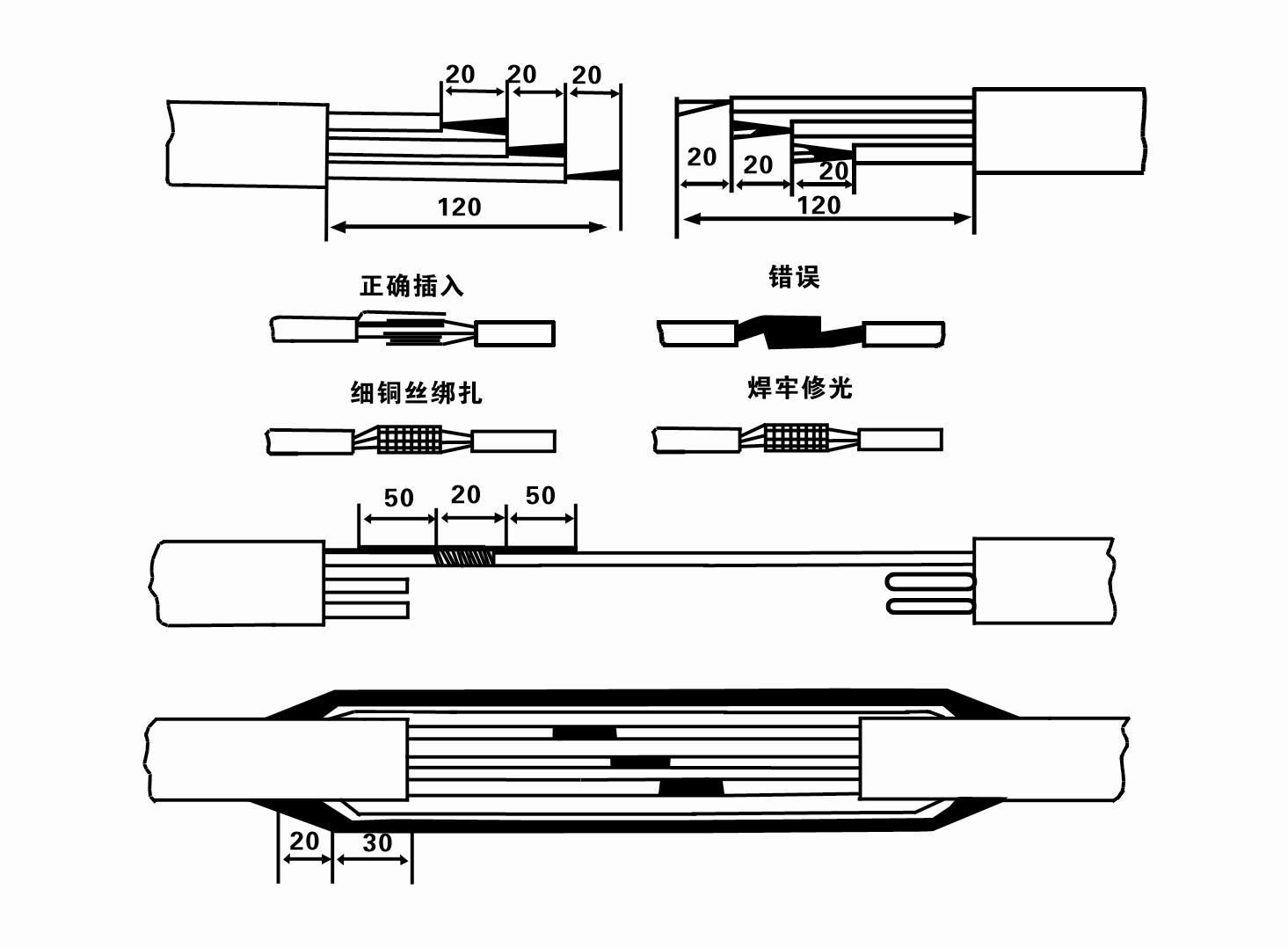
8. E hoʻohana i ka multimeter no ka nānā ʻana inā pili ʻia nā uea ʻekolu ʻāpana a inā ʻaʻole kaulike ke kūpaʻa DC.
9. E nānā inā ua hoʻonui ʻia ka mana kaapuni a me ka mea hoʻololi, a laila hoʻohui i ke kī hoʻomalu overload a i ʻole nā mea hoʻomaka. E nānā i ka Papa 2 no nā hi'ohi'ona kiko'ī, a laila, e ninini i ka bākeke wai i loko o ka pā wai mai ka puka wai e ho'oma'ama'a i ka pahu pahu i loko o ka pama, a laila e kau i ka pauma uwila i lalo i luna a pa'a. a e nānā inā pili ka hoʻokele me ka hōʻailona hoʻokele. Inā ʻaʻole, e hoʻololi i nā mea hoʻohui ʻelua o ke kaula ʻekolu. Inā hoʻohana ʻia i nā hanana kūikawā (e like me nā ʻauwai, nā ʻauwai, nā muliwai, nā loko, nā loko, a me nā mea ʻē aʻe), pono e hoʻopaʻa ʻia ka paila uila.
(2) Mea hoʻokomo a me nā mea hana:
1. Hoʻokahi mau kaulahao hāpai no ʻelua mau tona.
2. ʻO kahi tripod me ke kiʻekiʻe kū i lalo o ʻehā mau mika.
3. ʻElua kaula kau (wire ropes) hiki ke kaumaha i ke kaumaha ma mua o hoʻokahi tona (hiki ke halihali i ke kaumaha o ka pahu wai piha).
4. E hoʻouka i ʻelua mau paʻi (splints).
5. Nā wrenches, hammers, screwdrivers, uila a me nā mea kani, etc.
(3) Hoʻokomo ʻia ka pauma uila:
1. Hōʻike ʻia ke kiʻikuhi hoʻonohonoho o ka pauma uila submersible ma ka Figure 2. Hōʻike ʻia nā ana hoʻonohonoho kikoʻī ma ka Papa 3 "List of Installation Dimensions of the Submersible Electric Pump".
2. Hiki ke hoʻokiʻekiʻe pololei ʻia nā paila uila me ke poʻo ma lalo o 30 mika i loko o ka pūnāwai me ka hoʻohana ʻana i nā paipu a me nā kaula uwea a i ʻole nā kaula hemp ʻē aʻe e hiki ai ke halihali i ke kaumaha piha o ka mīkini holoʻokoʻa, nā paipu wai, a me ka wai i loko o nā paipu.
3. ʻO nā pumps me ke poʻo i ʻoi aku ma mua o 30 mika e hoʻohana i nā paipu kila, a penei ka hoʻonohonoho ʻana:
①E hoʻohana i kahi pipili no ka hoʻopaʻa ʻana i ka ʻaoʻao o luna o ka ʻaoʻao o ka pauma wai (ua hoʻopili ʻia ke kaʻa a me ka pauma wai i kēia manawa), e hoʻokiʻekiʻe me ke kaulahao e kau ana, a nakinaki mālie i loko o ka luawai a kau i ka paʻi ma ke poʻo punawai a wehe i ke kaulahao. kaulahao e kau ana.
② E hoʻohana i nā paipu ʻē aʻe e hoʻopaʻa i ka paipu, e hoʻokiʻekiʻe me ke kaulahao e kau ana ma kahi mamao o 15 knm mai ka lehelehe, a e hoʻohaʻahaʻa mālie. Ma waena o ka flange paipu a me ka flange pump E hoʻopaʻa i ka pā hao a hoʻopaʻa i ka paipu a paʻa pono me nā bolts, nati a me nā mea holoi puna.
③ E hoʻokiʻekiʻe iki i ka pauma hoʻohaʻahaʻa, e wehe i ke kaula ma ka ʻaoʻao o luna o ka pā wai, e hoʻopaʻa paʻa i ke kaula i ka paipu wai me ka lipine plastik, a nakinaki mālie i lalo a kau ʻia ka paʻi ma ka luawai.
④E hoʻohana i ke ʻano like e hoʻopaʻa ai i nā paipu wai a pau i loko o ka pūnāwai.
⑤Ma hope o ka hoʻopili ʻia ʻana o ke kaula alakaʻi i waho i ka hoʻololi mana, ua hoʻopili ʻia i ka lako mana ʻekolu.
(4) Nā mea e nānā ai i ka wā e hoʻokomo ai:
1. Inā ʻike ʻia kahi mea hoʻopuʻi i ka wā o ka pahū ʻana, e hoʻohuli a huki paha i ka paipu wai no ka lanakila ʻana i ke kiko pahu. Inā ʻaʻole e holo nā ʻano hana like ʻole, e ʻoluʻolu, mai hoʻoikaika i ka pamu i lalo e pale aku i ka pōʻino o ka pauma uila a me ka luawai.
2. I ka wā o ka hoʻokomo ʻana, pono e kau ʻia kahi pā hao ma ka ʻaoʻao o kēlā me kēia paipu a paʻa pono.
3. Ke hoʻohaʻahaʻa ʻia ka paila wai i loko o ka pūnāwai, pono e hoʻokomo ʻia i waenakonu o ka paipu pūnāwai i mea e pale ai i ka holo ʻana o ka pamu i ka paia o ka pūnāwai no ka manawa lōʻihi, e hoʻonāwaliwali ai ka pamu a e kahili a wela ke kaʻa. .
4. E hoʻoholo i ka hohonu o ka paila wai a hiki i lalo o ka luawai e like me ke kahe ʻana o ke one a me ka lepo o ka luawai. Mai kanu i ka pamu i ka lepo. ʻO ka mamao mai ka pā wai a hiki i lalo o ka pūnāwai ʻaʻole i emi iho ma mua o 3 mika (e nānā i ke Kiʻi 2).
5. ʻAʻole emi ka hohonu o ke komo ʻana o ka wai ma lalo o 1-1.5 mika mai ke kiʻekiʻe o ka wai ikaika a hiki i ka node inlet wai (e nānā i ke Kiʻi 2). Inā ʻaʻole, hiki ke pohō maʻalahi nā bearings pump wai.
6. ʻAʻole hiki ke haʻahaʻa loa ka hāpai ʻana o ka paila wai. A i ʻole, pono e hoʻokomo ʻia kahi valve puka ma luna o ka pipeline wai punawai e hoʻomalu i ke kahe ʻana o ka paila ma ka helu kahe i helu ʻia e pale ai i ka hoʻonui ʻia ʻana o ke kaʻa a puhi ʻia ma muli o nā kahe kahe nui.
7. I ka holo ana o ka pauma wai, pono e hoomau ka puka ana o ka wai a me ke ano, pono ke kupaa (ma lalo o na kulana hana i heluia, ma ke ano, aole oi aku mamua o 10% o ka manawa i heluia), a aole e haalulu a walawala. Inā loaʻa kekahi mea ʻino, pono ke kāpae ʻia ka mīkini e ʻike i ke kumu a hoʻopau.
8. I ka wā e hoʻokomo ai, e hoʻolohe i ka hoʻonohonoho ʻana o ka uea hoʻopaʻa ʻia kaʻa (e nānā i ke Kiʻi 2). Inā he paipu kila ka paipu wai, e alakaʻi iā ia mai ka puʻu punawai; inā he paipu plastik ka paipu wai, e alakaʻi iā ia mai ka hōʻailona kumu o ka paila uila.
- 1.After the submersible pump is installed, check the insulation resistance and three-phase conduction from the switch again, check whether the instrument and the connection of the start 2.equipment are wrong, if there is no problem, the trial machine can be started, and observe whether the indicator readings of the instrument exceed the rated voltage and current specified on 3.the nameplate after the start, and observe whether the pump has noise and vibration phenomenon, and put into operation if everything is normal.
- 4.After the first operation of the pump for four hours, the motor should be shut down to test the thermal insulation resistance quickly, and its value should not be less than 0.5 megaohm.
- 5.After the pump is shut down, it should be started after five minutes to prevent the water column in the pipe from being completely reflowed and causing excessive motor current and burnout.
- 6.After the pump is put into normal operation, in order to prolong its service life, it is necessary to check whether the supply voltage, working current and insulation resistance are normal regularly. If the following conditions are found, the pump should be shut down immediately to troubleshoot.
- 1 In the rated condition, the current exceeds 20%.
- 2 Ke hāʻule nei ka pae wai ikaika i ka ʻāpana komo wai, e hoʻoulu ai i ka wai.
- 3 He haʻalulu koʻikoʻi ka haʻalulu a walaʻau paha ka pauma submersible.
- 4 ʻO ka haʻahaʻa haʻahaʻa ma mua o 340 volts.
- 5 Ua pau ka fuse.
- 6 Poino ka paipu wai.
- 7 The motor's thermal insulation resistance is lower than 0.5 megaohm.
- Unit disassembly:
- 1 Untie the cable tie, remove the pipeline part, and remove the wire plate. 2 screw down the water bolt, put the water in the motor chamber.
- 3 e wehe i ka kānana, e wehe i ka wili paʻa ma ka hui ʻana e hoʻoponopono i ke kumu kaʻa.
- 4 hoʻokuʻu i lalo i ka pahu e hoʻopili ai i ka ʻāpana komo wai me ka mīkini, a hoʻokaʻawale i ka pamu mai ke kaʻa (e nānā pono i ka cushion unit i ka wā e hoʻokaʻawale ai, e pale ai i ka piʻo ʻana o ke kumu paʻa)
- 5 ʻo ke kaʻina hoʻokaʻawale ʻana o ka paila: (e nānā i ke kiʻi 1) ʻāpana komo wai, impeller, diversion shell, impeller...... nānā i ke kino valve, i ka wā e wehe ai i ka impeller, e hoʻohana i nā mea hana kūikawā e wehe i ka lima conical o ka paʻa. impeller mua, a pale aku i ke kulou ana a me ka hoeha ana i ke kumu o ka pauma ma ke kaʻina o ka wehe.
- 6 ʻO ke kaʻina o ka wehe ʻana o ke kaʻa: (e ʻike i ke kiʻi 1) kau i ke kaʻa ma luna o ke kahua, a wehe i nā nati, ke kumu, ke poʻo laka paʻa, ka pā kī, ke kī, ka noho alakaʻi alakaʻi haʻahaʻa a me ka pahu poʻo pālua mai lalo o ke kaʻa, a laila lawe i ka rotor (e makaʻala i ʻole e hōʻino i ka pūʻolo uea) a hope e wehe i ka ʻāpana hoʻohui a me ka noho alakaʻi alakaʻi luna.
- 7 hui hui: ma mua o ka hui ʻana, pono e hoʻomaʻemaʻe ʻia ka ʻōpala a me ka lepo o nā ʻāpana, a uhi ʻia ka ʻili a me nā mea hoʻopaʻa me ka sealant, a laila hoʻohui ʻia ma ke ʻano ʻē aʻe o ka wehe ʻana (e neʻe ka pahu kaʻa i luna a i lalo ma hope o ka hui ʻana ma kahi o hoʻokahi. millimeter), ma hope o ka hui ʻana, pono e maʻalahi ka hui ʻana, a laila ka mīkini hoʻāʻo kānana. E lawe ʻia nā pauma i loko o ka luawai no ka wehe ʻana a me ka mālama ʻana e like me ka Paukū 5 ma hope o hoʻokahi makahiki o ka hana ʻana, a i ʻole ma lalo o hoʻokahi makahiki o ka hana ʻana akā ʻelua mau makahiki o ka luʻu ʻana, a e hoʻololi ʻia nā ʻāpana kahiko.
In order to ensure the long-term use and stable performance of submersible electric pump, we have launched a convenient and practical product. The product has a unique design, easy operation, and is perfect for various application scenarios. After use, remember to discharge all the water in the electric pump, especially in winter, so as not to freeze the motor. Wind the cable and bundle it. Store it in an environment without corrosive substances and gases, and keep the temperature below 40 °C. In addition, if you do not use it for a long time, you should pay attention to prevent the submersible electric pump from rusting. Choose our products to make your work more convenient and efficient.
- Mea hoʻolele
- Puʻu lima
- Ka lima lāʻau lāʻau
-
apo apo
01 Hoʻokomo wai hohonu
02 Waiwai kiʻekiʻe
03 lako wai mauna
04 hale kiaʻi wai
05 Ka wai mahiai
06 ka hoʻoulu ʻana i ka māla
07 hoʻokomo wai kahawai
08 wai hale

